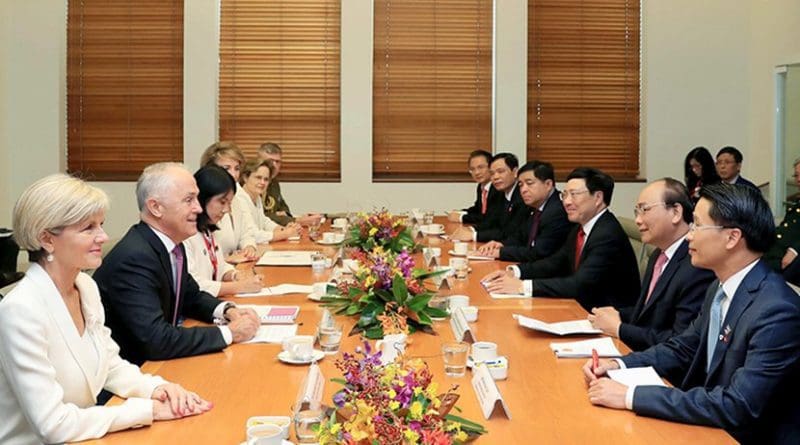New Strategic Partnership: A New Dawn In Vietnam-Australia Ties – Analysis
Vietnam, the rising star of Asia with an impressive economic growth of 6.8 percent, has been building new partnerships and solidifying old relations with strategic partnerships with influential countries like India, Indonesia, Japan and Thailand in recent years.
Australia is the newest addition to this list.
On Thursday (March 15), Vietnamese Prime Minister, Nguyen Xuan Phuc, and his Australian counterpart, Malcolm Turnbull, signed the historic new strategic partnership in Canberra, an important move to upgrade political, defence, trade and investment ties between the two countries.
It was not only a big step but also a new dawn in both countries’ 45-yeal old relations. Both countries established their diplomatic ties in 1973.
“As new strategic partners, Australia and Vietnam have agreed to work together to realize a vision of a secure, open and prosperous region,” Turnbull said on Thursday.
Echoing a similar view, Phuc said that the enhancement of ties were meant for the benefit of the both countries.
“The upgrading of bilateral relations to Strategic Partnership is momentous, opening up a new chapter in our bilateral relations, elevating the relations to new heights as well as adding depth and substance to the bilateral cooperation for the benefits of our two peoples, and for peace,” Phuc told the Fairfax Media in an interview.
The most interesting thing from the state visit of Phuc, a popular leader in Vietnam, to Australia, was the kind of red carpet welcome he received and rapport between him and Australian leaders. It was an extraordinary reception for a Vietnamese prime minister in Australia.
Phuc visited in Australia for both a state visit as well as to attend the ASEAN-Australia Special Summit.
The bilateral trade has been growing very well in recent years. Last year, it reached a record US$6.45 billion, an increase of more than 200 times compared to a mere $32.3 million in 1990.
Australia is currently Vietnam’s 15th largest trading partner while Southeast Asia is Australia’s eight biggest trading partner. Last year, Vietnam exported $214 billion worth of goods, mostly high-tech products, to all corners of the globe. With a reform-minded government in power, Vietnam has become a darling for foreign investors.
Vietnam mainly exports telecommunications equipment, electronic goods, shoes, clothing, computers and furniture to Australia while importing minerals like zinc, aluminium, coal, wheat, beef and cotton.
Australia has so far invested $1.82 billion in Vietnam in some 400 projects. Australia has also provided large amounts of official development assistance (ODA). For example, Australia provided A$84 million in ODA to Vietnam, a low middle-income country.
Both countries have been enjoying excellent defense ties for the last 20 years. But the most fruitful cooperation is in the educational sector.
Currently around 25,000 Vietnamese students are studying in Australia while 1,500 Australian students are studying in Vietnamese universities.
Australian tourists are showing more interest in Vietnam nowadays as 285,000 tourists visited Vietnam in 2017. Moreover, based on the Australian 2016 Census, there are some 300,000 Australians who have Vietnamese ancestry.
The new strategic partnership comes at the right time as Chinese assertiveness in the region, especially in the South China Sea, has been on the rise. Vietnam is the second biggest claimant in the South China Sea conundrum and Australia shares Vietnam’s concerns about China’s assertiveness and its unilateral actions. Both countries seek a rules-based regional order to address maritime disputes or concerns.
Both Australia and Vietnam, unlike the US under President Donald Trump, are staunch supporters of globalization and free trade. Both countries signed the latest Comprehensive and Progressive Agreement for Trans-Pacific Partnership (CPTPP) and also the ASEAN-Australia-New Zealand Free Trade Agreement (AANZFTA). They are also participating in the negotiations to conclude the Regional Comprehensive Economic Partnership (RCEP), in which China is also a participant.
Vietnam also wants to cooperate with Australia in establishing start-ups, SMEs and developing the digital economy.
Last year, Turnbull visited Vietnam to attend the Asia-Pacific Economic Cooperation (APEC) Leaders’ summit.
Now that Phuc has visited Australia, this may give a big boost to the relations and interaction between the two countries.
The ASEAN-Australia Special Summit is also an important gathering in Sydney. Vietnam, as a fast growing economy, is indeed an important strategic partner for Australia. The summit will discuss various issues like education, economic cooperation, countering terrorism and other regional security challenges including North Korea and tensions in the South China Sea.
Prior to his visit to Australia, Prime Minister Phuc visited New Zealand, where he received a warm welcome.
During his four-day visit from March 11-14 to New Zealand, Phuc held very fruitful discussions with New Zealand Prime Minister Jacinda Ardern and witnessed the signing of various cooperation agreements.
Both Vietnam and New Zealand established their diplomatic ties in 1975. Economic and political ties have been on the rise. Last year, bilateral trade reached $1.2 billion, a 30 percent increase compared to the trade value in 2016.
In a nut shell, Phuc’s visit to both New Zealand and Australia, especially the signing of a new strategic partnership with Australia, has boosted Vietnam’s global image and has generated an enormous interest in Australian and New Zealand investors to do business with this Southeast Asian country.
The upgrade in Vietnam’s relations with Australia and New Zealand are vital to form a regional coalition to maintain the peace and security in Southeast Asia. With the growing economic weight and military might of China, ASEAN is deeply concerned with regional security. Of late, ASEAN has been active in fostering partnerships with countries like Japan, India and now, Australia. In all these efforts, there is a need for a bigger role of Indonesia, the de facto leader of ASEAN, and Vietnam, the rising star of Asia, to maintain ASEAN unity and peace in the region.

